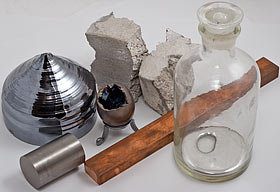Hello, my name's Dan, and I collect science toys.
I never really thought about it like that before. I just like science toys, so I buy (and occasionally make) them. But now I suppose I have a collection.
Apart from enough physical, chemical and (not always on purpose) biological substances and apparatus to see me put away forever as the ringleader of, um, something bad, I have, to start with, accumulated a small selection of...

...elements. Since I took that picture I've got myself some titanium (so I could do a bit of this), and a bag of nickel electrode buttons, and one of RGBco's 92 gram magnesium cylinders to go with the same-sized 1005 gram tungsten cylinder in the picture.
In a more distinctly toy-ish sense, there's my...

...Wimshurst machine, the little steam and Stirling engines that have a cameo in this piece, the trebuchet, various office toys of inconsistent educational value, a bunch of those fibre-optic synthetic-tiger-eye spheres, some prism glasses (which aren't actually very useful, but if you had to wear things like these you'd probably be glad of them), and some lasers and diffraction gratings and big Fresnel lenses (only this big, not this big).
(I'd love a pseudoscope, but I think I might just have to make my own rather than buy one...)
Oh, and tons of magnets (including three... large... ones that I store in different rooms), decorative discharge lamps large and small, and a giant lighter flint, and a recently acquired ingot of straight mischmetal, and my faithful little radiometer.
(I broke my Klein bottle. I must get another.)
And a couple of Slinkies. The little 35mm-diameter ones are excellent fiddle-toys. Only the steel ones, obviously; the plastic ones are rubbish.
I must get a decent gyroscope some time.
Mm.
Oh, you're still here. Anyway, if this list sounds fun to you, then head on over to Educational Innovations and try not to spend too much money.
Educational Innovations, you see, sell things for science teachers. Fun things for science teachers. Things for science teachers most of which I want in my own house.
I ordered some stuff from them a little while ago. They're in the USA and I'm in Australia, so shipping rates for bulkier contraptions are pretty steep, and I thus had an attack of sanity and pruned my order down to only two items. But their within-USA postage is quite cheap, and their actual prices are quite reasonable. They resell quite a lot of items that I've seen on sale elsewhere - including that RLT trebuchet kit - but they don't crank up the prices, as many educational suppliers seem happy to do.
Educational Innovations are enthusiastic about the "Super, Wow, Neat!" concept, in which teachers are apparently meant to improve the self-esteem of their students by showing them that no matter how dorky they may think themselves to be, the teacher is a thousand times worse. If you manage to control your urge to hit them, though, their site is quite plain sailing - and their paper catalogue is outstanding.
And no, I do not have an affiliate deal with them.
(The two things I bought, by the way, were the fire syringe and the smashing spheres. It occurs to me now that a set of boules might be just as good for the second demo. You can also get ball bearings in a variety of huge sizes.)
More about the fire syringe, also known as a fire piston. (It has funny instructions!)

